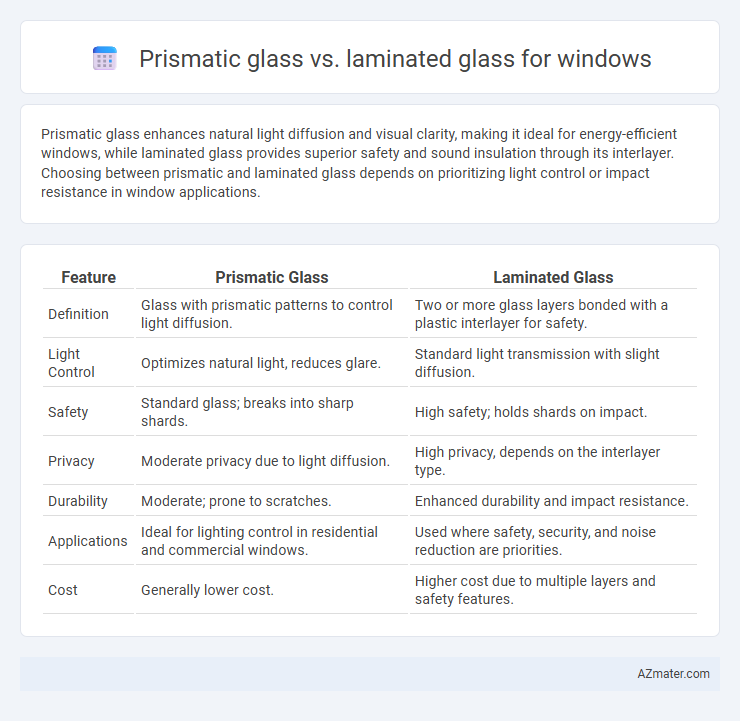Prismatic glass enhances natural light diffusion and visual clarity, making it ideal for energy-efficient windows, while laminated glass provides superior safety and sound insulation through its interlayer. Choosing between prismatic and laminated glass depends on prioritizing light control or impact resistance in window applications.
Table of Comparison
| Feature | Prismatic Glass | Laminated Glass |
|---|---|---|
| Definition | Glass with prismatic patterns to control light diffusion. | Two or more glass layers bonded with a plastic interlayer for safety. |
| Light Control | Optimizes natural light, reduces glare. | Standard light transmission with slight diffusion. |
| Safety | Standard glass; breaks into sharp shards. | High safety; holds shards on impact. |
| Privacy | Moderate privacy due to light diffusion. | High privacy, depends on the interlayer type. |
| Durability | Moderate; prone to scratches. | Enhanced durability and impact resistance. |
| Applications | Ideal for lighting control in residential and commercial windows. | Used where safety, security, and noise reduction are priorities. |
| Cost | Generally lower cost. | Higher cost due to multiple layers and safety features. |
Introduction to Prismatic and Laminated Glass
Prismatic glass features a textured surface or internal prisms designed to refract and distribute natural light evenly within a space, enhancing daylighting and reducing glare. Laminated glass consists of two or more glass layers bonded with an interlayer, offering improved safety, sound insulation, and UV protection. Both types serve distinct architectural and functional purposes: prismatic glass optimizes light transmission, while laminated glass prioritizes strength and security.
Understanding Prismatic Glass: Features and Functions
Prismatic glass enhances natural light distribution with its geometric patterns that refract and diffuse sunlight, reducing glare and improving indoor brightness. This glass type features a textured surface designed to optimize daylight penetration while maintaining privacy and minimizing heat gain. Unlike laminated glass, which prioritizes safety and impact resistance through its interlayer, prismatic glass focuses on light management and energy efficiency in window applications.
Laminated Glass: Composition and Key Benefits
Laminated glass consists of two or more glass layers bonded together with an interlayer, typically made of polyvinyl butyral (PVB), which enhances safety by preventing shards from scattering upon impact. This composition provides superior noise reduction, UV protection, and increased resistance to forced entry compared to prismatic glass. Its key benefits include improved security, enhanced energy efficiency, and effective sound insulation, making it ideal for residential and commercial window applications.
Visual Clarity and Light Diffusion Comparison
Prismatic glass offers superior light diffusion by refracting sunlight to evenly distribute natural light within spaces, reducing glare and enhancing visual comfort. Laminated glass provides excellent visual clarity with its multiple layers bonded together, ensuring safety and sound insulation while maintaining transparency. Compared to laminated glass, prismatic glass excels in scattering light efficiently, making it ideal for environments requiring glare control and uniform lighting.
Energy Efficiency: Which Glass Performs Better?
Prismatic glass enhances energy efficiency by diffusing sunlight, reducing glare and heat gain while maximizing natural light penetration, which can lower cooling costs in warm climates. Laminated glass offers excellent insulation and soundproofing properties, with a special interlayer that improves thermal performance by reducing heat transfer and UV radiation exposure. When prioritizing energy efficiency, the choice depends on specific climate needs: prismatic glass excels in light diffusion and heat reduction, while laminated glass provides superior insulation and UV protection.
Safety and Security: Prismatic vs Laminated Glass
Laminated glass offers superior safety and security compared to prismatic glass due to its multi-layer construction that holds shards in place upon impact, reducing injury risks and preventing easy break-ins. Prismatic glass primarily enhances light diffusion and privacy but lacks the reinforced structure that blocks forced entry or provides shatter resistance. For windows prioritizing protection against impacts, break-ins, and accidents, laminated glass remains the optimal choice.
Acoustic Insulation Properties
Prismatic glass offers moderate acoustic insulation by diffusing sound waves through its textured surface, reducing noise transmission in window applications. Laminated glass provides superior acoustic insulation due to its interlayer, typically made of polyvinyl butyral (PVB), which dampens sound vibrations and minimizes noise penetration. Windows with laminated glass achieve higher Sound Transmission Class (STC) ratings compared to prismatic glass, making them more effective for noise-sensitive environments.
Durability and Maintenance Requirements
Prismatic glass offers enhanced durability due to its textured surface that disperses impact energy more effectively than standard glass, reducing the likelihood of cracks and chips. Laminated glass consists of multiple layers bonded by an interlayer, providing superior resistance to shattering and improved safety, making it highly durable in extreme conditions. Maintenance for prismatic glass is minimal, requiring regular cleaning to preserve light diffusion properties, while laminated glass demands careful inspection of the interlayer for any delamination or moisture ingress to ensure long-term integrity.
Cost Analysis: Upfront and Long-Term Expenses
Prismatic glass typically has a higher upfront cost due to specialized manufacturing processes, but its enhanced light diffusion can reduce energy expenses by improving natural daylighting and lowering artificial lighting needs. Laminated glass, while often less expensive initially, offers long-term value by providing superior safety, noise reduction, and UV protection, potentially lowering maintenance and replacement costs. Evaluating total cost of ownership for windows involves weighing prismatic glass's energy savings against laminated glass's durability and protective benefits.
Conclusion: Choosing the Ideal Glass for Your Windows
Prismatic glass excels in diffusing natural light evenly, reducing glare and enhancing privacy, making it ideal for living spaces and offices. Laminated glass offers superior safety and sound insulation, which suits windows in high-traffic areas or locations prone to impact. Selecting between prismatic and laminated glass depends on whether your priority is light management or security and noise reduction for your windows.

Infographic: Prismatic glass vs Laminated glass for Window
 azmater.com
azmater.com